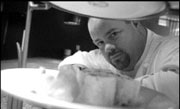SEASTAR RESTAURANT AND RAW BAR 205 108th N.E., Bellevue, 425-456-0010 lunch weekdays, dinner daily
After years of disappointments mild and severe, I came up with a rule of thumb about dining out on the Eastside: Take careful note of restaurant ratings by friends, reviewers, and guidebooks, take an average, and then divide by two. There are some darn good restaurants tother side the floating bridges, but crossing water seems to weaken people’s culinary judgment: I’ve never eaten at one that I didn’t feel had been overpraised.
Until now. Seastar, John Howie’s five-month-old restaurant in the new Civica Building on the southeast edge of downtown Bellevue, is the authentic, unapologetic Real Thing—in look, atmosphere, and, above all, food. If anything, advance reports understated what Howie has done. Seastar has raised the bar for Eastside fine dining.
Restaurants specifically conceived to fit into office complexes are fairly common in big urban centers like Chicago and New York, but they’re still a rarity in these parts: Seastar is the first I’ve visited that I feel pulls the trick off. Opening off a nondescript atrium/plaza, the restaurant wraps around three sides of one of its building’s wings, with windows that look out to the street all round.
Despite the U-configuration, the rooms are comfortably spacious, the walls unadorned brushed steel and wood veneer but not self-consciously stark, the high ceilings devoid of the usual clutter of camouflaged air ducts and wiring. The decor is cool, clean, and self-effacing; the tables comfortably spaced, their settings simple. Only a continuous drizzle of late bad- period Sinatra on the sound system compromises the atmosphere of confident good taste.
The menu (constantly changing, so don’t count on finding the same dishes described here) seems at first sight fairly conventional: lots of straightforward seafood items like jumbo prawn cocktail ($14.95), crab cakes ($11.50), cedar-plank salmon ($22.95), grilled halibut ($20.95), each with ingredients and treatment simply described. It’s not until your order arrives that you learn that Howie saves his inspiration for the plate, not the prose in the menu. That halibut, for example: barely seasoned before being cooked to moist flaky perfection but served atop a mound of . . . what shall I call it? The menu says “roasted corn mashed potatoes,” but that doesn’t begin to do justice to the fragrant rosy-brown pur饬 perfectly setting off the firm fish with its unctuous, creamy, cheesy texture. A splash of avocado-tomatillo relish and just a dab of roasted pepper sauce between them box the compass with a variety of flavors.
Exhibit B: the appetizer portion of flash-seared diver scallops ($10.50)—nothing but just-firm, delicate pale pink morsels but surrounded by a veritable fiesta of finely diced tropical fruits in an incredibly complex dressing mingling a classic beurre blanc and concentrated white balsamic vinegar with a syrup flavored with brown sugar, vinegar, sweet onion, and finely minced ginger. You find yourself slicing your scallops into smaller and smaller wedges just to have something to mop up the fruit and its honey-colored dressing with.
If you had to categorize Howie’s menu, you’d have to call it “fusion”: The grilled chicken breast ($16.95) is marinated in miso and tangy with ginger, served on sushi rice, and dolloped with toasted sesame seeds; there’s a halibut ceviche that’s almost a salad, tossed with cilantro, onions, and jalape�in a tangy pico de gallo sauce; the “hot and sour shrimp soup” ($3.95/$5.95) is Thailand’s fiery tom yum goong in all but name.
But despite their varied countries of origin, Howie’s recipes fit cozily together. The only “fusion” going on is in the chef’s mind. “I’ve taken what I love to eat and put it on my menu,” he says flatly. But in 20 years or so in the restaurant game, both casual and white tablecloth, he’s mastered an even more important mantra of the trade: “Listen to what your guests want.” Judging by the number of people in the place every night, he’s listened well.
After several visits, I find the key quality that sets Seastar apart is its determination to be a restaurant—not a sanctum, not an Experience, a novelty shop, a theme park, a lark—a restaurant: a place you come to pay attention to what you’re eating and drinking. The martini in the bar is as carefully composed as the balance of herbs, wine, and butter in the transcendent pesto-steamed butter clams ($11.50), the wine list as polished and tweaked (by master sommelier Eric Liedholm) as the Mediterranean flavor medley (garlic, capers, citrus, smoky mushrooms, and buttery artichoke hearts) the chef has crafted to accompany a simple dish of true sea bass ($22.95).
Desserts are as carefully considered and lovingly executed as the rest of the menu. A banana “spring roll” wallows in vanilla-orange-caramel-pineapple ice cream and sauce ($5.95); roasted peaches and nectarines lurk between fresh-baked butter cookies in a Grand Marnier cream ($6.50); a passion fruit panna cotta rises like a cloud-enshrouded tropical island from a green-tea-syrup sea stained red by raspberry-mango coulis ($6.95).
Seastar serves lighter versions of evening entr饳 at lunch; for even lighter dining, there’s oysters and ceviches, sushi, sashimi, and poke from the raw bar. You can even get a deli-style sandwich (turkey or pastrami, $3.95 half/$7.50 whole) with a side of Tim’s chips. But to appreciate Howie’s brilliance, you really have to sit down and dig in at dinner. There’s not a better restaurant in these parts. And it’s in Bellevue.









